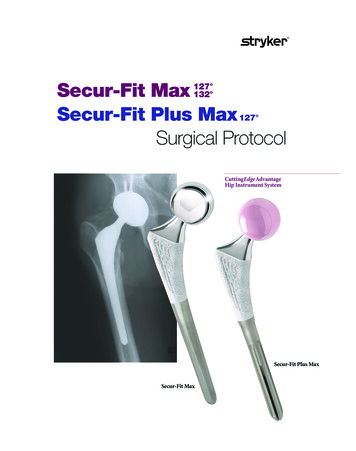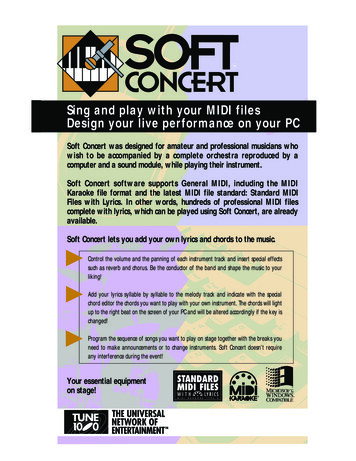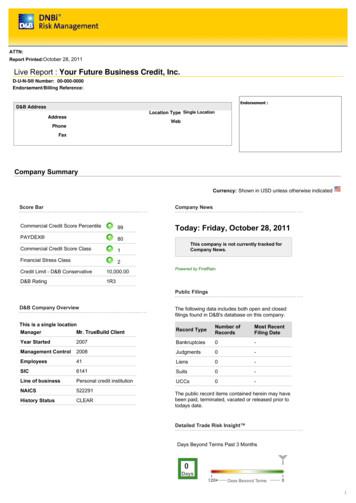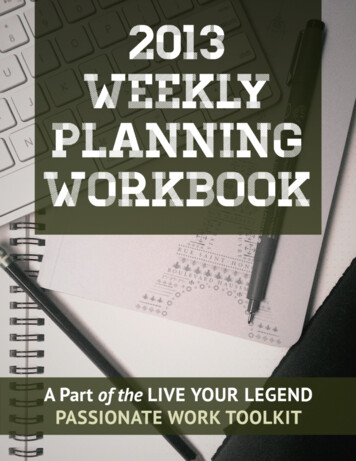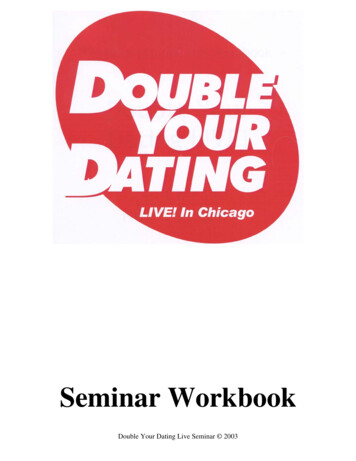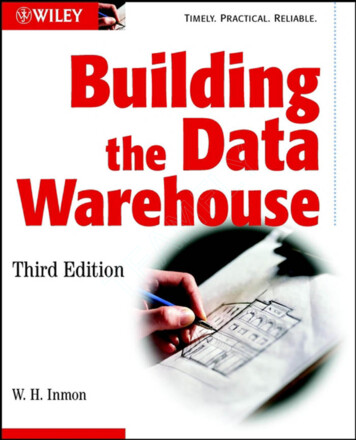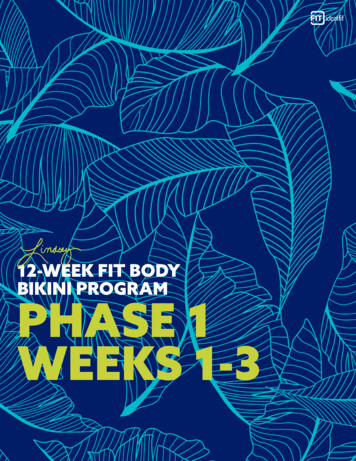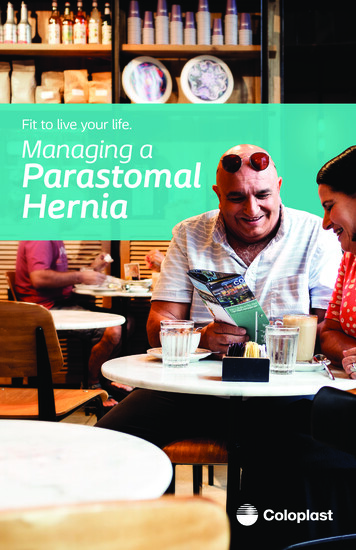
Transcription
Fit to live your life.Managing aParastomalHernia
What is a parastomal hernia?When you had your ostomy surgery, a section of your bowel was brought outthrough an incision (cut) in your abdominal wall to create the stoma. This openingmay cause a weakness in the abdominal wall, allowing the bowel to push forward(see diagram below).There are many different types ofIf you already have a herniahernias that people can develop,around your stoma, we will provideand reasons they occur willsome hints and tips on what youdepend on individual risk factors.can do to protect and supportThis booklet is designed to helpyour abdominal muscles.you reduce your personal risks.Loop ofbowel (hernia)Abdominal wallStomaBowel
Am I at risk of developing a hernia?Your abdominal muscles are essential for your daily life. You use them all the timefor everyday body movements. They collectively form your ‘core’ which: Provides protection for your internal organs and spine Promotes movement and balance to the front and back of your body Provides stability and strength to maintain good postureTransverse abdominisLocated underthe obliques, it isthe deepest of theabdominal musclesand wraps around yourspine for protection andstability.Internal abdominalobliqueLocated under theexternal obliques,running in the oppositedirection.External abdominalobliqueLocated on the sideand front of theabdomen.Rectus abdominisLocated along the frontof the abdomen, this isthe most well-knownabdominal muscle;often referred to as the‘six pack’.Understanding what your core muscles do (with or without a stoma) is important inknowing how you can reduce your chance of a hernia developing.There are a number of factors that can increase someone’s risk of developing a herniaFor example: Straining your abdominal muscles – e.g.poor lifting technique of heavy objects, ormanual labor without proper support Weak core muscle strength Being overweight – causes unduepressure and strain around your abdomen Smoking - reduces the oxygen in thetissuesAnd your medical history: A previous history of hernia Emergency surgery or sepsis High dose steroidsA grapefruit sized parastomal hernia.
How do I reduce my riskof developing a hernia?After SurgeryThe 12 weeks after your surgery is theMOST important time to be careful.What you should doWhy should I do thisMaintain good postureThis will help to strengthen yourcore muscles.Stand tall, sit up straight.Start gentle exerciseSuch as the Core 4 to strengthen yourabdominal muscles.Wear ‘support’ garmentsThese can be purchased from mostdepartment stores or online.Support belts are also available online orfrom medical supply distributors.If you feel you are about tocough or sneezePlace a small cushion over your abdominalarea, and push against your stomachmuscles.Do not smokeAvoid inflicting any strainon those healing ‘core’ abdominal muscles.Avoid lifting over 5 pounds for 6-8 weeksafter surgery2, including vacuuming, doingthe laundry, ironing or mowing the lawn.This will build the strength and stabilityback to your core muscles. Theseexercises have been approved byphysical therapists and colorectalsurgeons.These will offer support to the musclesfrom the outside. Many people find theadditional support over the ostomypouch is helpful too.This will provide extra support tothe muscles as a cough orsneeze exerts internal pressureon the weakened muscles.Research shows that smokingincreases your risk of developing anincisional hernia four times more thanthose who don’t smoke.1When you lift something heavy, itincreases your abdominal pressure.Since your muscles are still recovering,this sudden increase in pressure maycause a hernia to form.Check with your surgeon or ostomy nurse before you start anything new.
Keeping your risks lowAfter three months of practicing these recommendations, you will have established goodbehaviors that will help decrease your risk of hernia development. It is important to continuethese practices.LiftingYour CoreYou should be gradually re-introducingyour normal “heavier” activities. Goodlifting technique is very important now.Remember: Bend your knees and keepa straight back. Stay focused on your abdominalstrength. Maintain the Core 4 ona daily basis. Stay focused on good,straight posture.Smoking Cessation Exercise regularly and build theintensity carefully. It is possible todo any sport/exercise that youwish. Walking, jogging, running,cycling, dancing, swimming orgroup exercise classes are allgood activities to start with. Just take care.Remember – Don’t take therisk of pushing your abdominalmuscles too hard, too suddenly. Smokers are four times more likelyto develop a hernia.3 Seek advice from your localpharmacist or physician to helpyou stop.Maintain a Healthy WeightIn a recent survey, 45% of ostomatesfelt they had put on more weightthan they liked following their ostomysurgery4. Make sensible diet choicesthat support a healthy lifestyle. Abalanced diet will help you with this.Specific diet information is availableon www.coloplastcare.com/en-CA/ostomy/lifestyle/diet/
KatrynaShould I wear support garments?Wearing support garments such as support underwear or an ostomy support beltcan be very beneficial. Together with your core exercises, support garments mayreduce the development of a parastomal hernia.
What do we mean by supportgarments?This includes undergarments that are madewith a material which has lycra/elasticinterwoven into the garment. These can bepurchased at medical supply stores.We would advise you wear this type ofundergarment at all times.For men, high-waisted boxer shorts, orcycling shorts with lycra offer support overand around the stoma as well.These types of undergarments can bepurchased at retailers such as sportinggoods stores.Please remember this type of undergarmentwill NOT put pressure on your stoma and willnot stop it from working.What should I do if I needmore support?Support garments are available for thosewho are at greater risk of developing ahernia, or who already have a hernia.These support garments are made with amuch stronger material than regular supportunderwear and are not available throughstores, but rather through specialty suppliers.They are available in the form of belts,underwear and girdles, and come in anumber of different strengths of support.However, as the position of everybody’sstoma is different on their abdomen and eachperson’s risks vary - it is strongly advised thatyou are measured and fitted appropriately bya specialist or ostomy nurse.Following this assessment, advice wouldbe provided on how to obtain the productsdirectly or in some cases, with a prescription.Are there other ostomyproducts designed to fit peoplewith a hernia?There is a new pouchingsystem that is speciallydesigned for people witha hernia or outwardarea around the stoma.SenSura Mio Concave hugsthe outward area for a snugfit, resulting in less creasesand folds in the barrier, whichmay help to prevent leakage.For more information or torequest samples, visitwww.coloplast. ca/mioconcave
What should I doif I think I havea hernia?You may have noticed a lump or bulge aroundyour stoma, which may even be visible underyour clothing. The size or shape can vary fromthe size of a golf ball to the size of a grapefruit,or even larger.If you are concerned that you may havedeveloped a hernia, consult your ostomynurse, who can assess the area and adviseaccordingly.In some cases, your doctor may order a scanto confirm the diagnosis.The development of a hernia often changesthe shape of your abdomen and your stoma,which may cause issues with the fit andperformance of your current pouchingsystem. Start by checking your barrier cuttingas your stoma may have changed shape andmay be need to be remeasured. Contact yourostomy nurse for a reassessment to help youresolve issues – such as sore skin or leakagebefore they occur.Should I be worried?No. Hernias are a very common issue andrarely cause major complications.The most frequent symptom an individualmay experience is a dragging feeling ordiscomfort which often gets worse towardsthe end of the day, as your abdominalmuscles get tired. Strengthening your corewill make a difference.Will I need more surgery?The good news is that having a hernia aroundyour stoma does not necessarily mean youwill need further surgery. A hernia can besupported with special underwear or garmentsand through implementing key lifestylechanges.Taking steps to strengthen your core andmanage your weight will have a significantimpact on your well-being.Hernia treatment and management isnormally non-surgical, due to the potential forrecurrence.Your ostomy nurse or surgeon will be ableto advise you on the options for a repairof a hernia if deemed appropriate for yoursituation.Surgery is generally only indicated ifyou are experiencing other stomarelated issues such as: discoloration ofthe stoma, changes in stoma outputor persistent stoma managementissues. Major complications are rarewith a parastomal hernia, but if youhave symptoms of severe pain, stomacolour changes or no stoma output,you should immediately seek medicaladvice from your physician or localemergency department.
My Hernia Action PlanWhat should I do now?At this stage you either are looking to:1. Reduce your risk of developing a hernia2. Reduce the impact your hernia has onyour lifeReducing your risk of hernia - or the impact ahernia may have on your life - is very much inyour control – and all the steps here will helpyou lead a healthy lifestyle.Use our tool on the next page to helpstay focused on your journey!
I will stop smoking over the next2 monthsI will find some comfortablesupport underwear, and wear itI will seek advice from myostomy nurse on supportgarmentsStop smokingStart wearing supportunderwearSupport garmentswww.coloplast.ca/ostomycheckI’ll regularly check my stoma forchanges in shape or for issuesI will find out what my healthyweight should be, and make aplan so I can get thereTake control ofmy weightCheck stoma for changesI will take a 10-minute walkevery dayRegular exercisewww.coloplast.ca/core4I will do the Core 4 everymorning and eveningI will bend my knees whenI lift thingsThink before you liftCore 4 exercisesExampleThings that will helpWrite your own goals hereThis is what I will do.DateComplete this 6 weeks laterHow am I doing?Date
Exercising with a stoma starts with the Core 4Where it ends is up to youTummy TighteningBreathingWhen to startThis exercise can be started within days ofsurgery. Provided all is well, you can even startwhile you are still in hospital, and your recoveryis progressing normally.How to do itLie on your back, with your head supportedby a pillow and your knees bent as far as iscomfortable. Simply take a deep breath in andslowly exhale through your mouth.As you exhale, gently tighten up the deepmuscles in your lower tummy. You should feel avery gentle ‘tightening’. Do not try to lift yourbottom or press your back into the bed. Justhold this ‘brace’ feeling for a count of 3-5seconds, and then release. Breathe and relaxand then repeat 3-5 times.As you progress, you can do the exercise on thefloor without a pillow and aim for a ‘stronger’tightening feeling. Hold the ‘brace’ for a countof 10-15 and breathe deeply in and out 2 or 3times. Repeat up to 5 times. Place your handson your tummy so you can check and feel themuscles tightening.Try to do this 2 or 3 times per day.Knee RollsWhen to startIntroduce this exercise7-10 days after surgery.Always work within apain free range and keepthe movement very smallto begin with.How to do itLie on your back, with your head supportedby a pillow and your knees bent as far as iscomfortable. Arms out to the sides. Keep yourknees and ankles together and gently let yourknees begin to drop over to one side. Only go asfar as is comfortable, then carefully tighten yourtummy muscles and roll your knees over to theother side. Try to keep your shoulders down andyour head relaxed, looking up with your eyes.Aim for 5 rolls.As time goes on, you can increase the rangeso your knees drop lower and build up to 20repetitions.Try to do this 2 or 3 times per day.Pelvic TiltWhen to startThis exercise can alsobe done just daysafter surgery. Just start very gently and workwithin a small pain free range.How to do itLie on your back, with your head supportedby a pillow and your knees bent as far as iscomfortable. Very gently rock your pelvisupwards and flatten your back into the bed orfloor. You should feel your tummy and bottommuscles tighten a little. Rock back to yourstarting position and repeat. Initially just aimfor 5 repetitions, and go very gently.As you progress, allow your back to arch upa little more, and tighten your tummy morestrongly as you push your back into the floor.Build up towards 20 reps.Try to do this 2 or 3 times per day.Hip LiftWhen to startIntroduce this exercise7-10 days after surgeryand initially make sureyou do it very gently andwith a small movement,only going as high as feels comfortable.How to do itLie on your back, with your head supportedby a pillow and your knees bent as far as iscomfortable.Very gently tilt your pelvis backwards andtighten your pelvic floor muscles. Lift yourbottom off the bed/floor and slowly lift upvertebrae by vertebrae until your bottom isoff the bed. Lift your bottom as high as youcomfortably can. Hold this for a moment, thenslowly lower your spine and pelvis back down.Imagine you’re lifting a string of pearls off thefloor and back down again.Repeat 3-5 times initially building up to 10-15repetitions in time and lifting higher as you feelmore comfortable.Try to do this 2 or 3 times per day.Note! If you have any concerns aboutwhether or not you should do theexercises, talk to your ostomy nurse orsurgeon before you start.
Personal support for youColoplast Care is a support programdesigned to encourage and inspire peopleto lead a fulfilled life with an ostomy. Weprovide straightforward advice, tips foryour routine, and
My Hernia Action Plan What should I do now? Use our tool on the next page to help stay focused on your journey! Reducing your risk of hernia - or the impact a hernia may have on your life - is very much in your control – and all the steps here will help you lead a healthy lifestyle. At this stage you either are looking to: 1. Reduce your risk .
